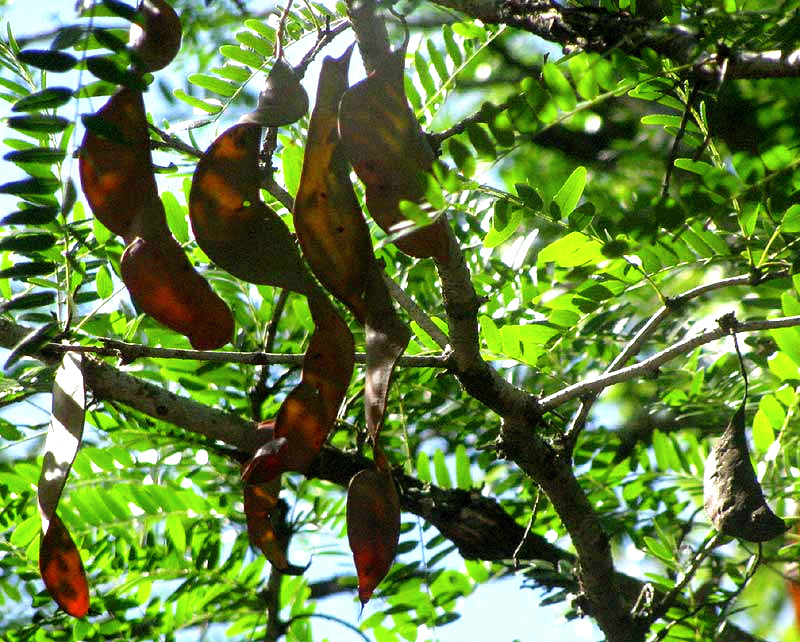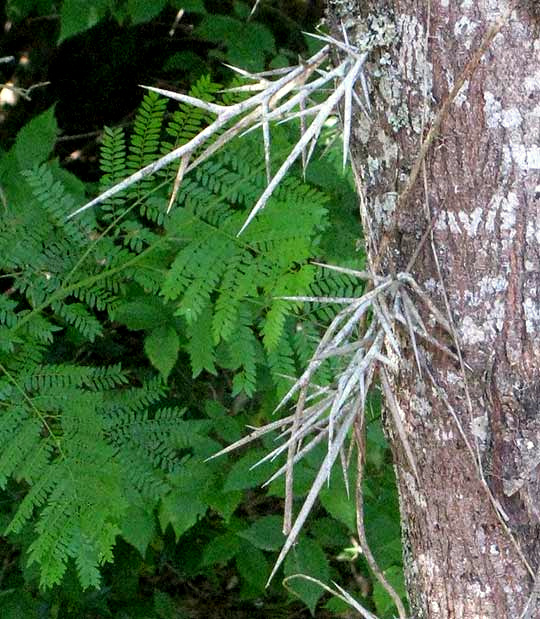Excerpts from Jim Conrad's
Naturalist Newsletter

from the July 8, 2012 Newsletter issued from the woods of the Loess Hill Region a few miles east of Natchez, Mississippi, USA
HONEY LOCUST
In moist, fertile soils along creeks and in bottomland woods, Honey Locusts, GLEDITSIA TRIACANTHOS, are putting on dark, twisty, foot-long (30cm) legume-type fruits that dangle conspicuously among their acacia-like leaves, as shown above. Legume fruits and acacia-like leaves attest to the Honey Locust's membership in the big Bean Family. The tree's twice-pinnate leaves are shown below:

As a kid on the farm in Kentucky my main thoughts about Honey Locusts concerned their branched spines that could grievously injure bare feet. Honey Locust spines have stabbed deep into my feet, even through the gummy soles of gym shoes, and back when I was driving I got more than one flat tire by running over the spines on forest roads. You can see such spines about eight inches long (20cm) growing from a tree's trunk below:

You can imagine that such spines can keep critters like opossums from climbing the trunks -- which they might want to do in order to eat the soft, developing fruits. When the legumes are mature they drop to the ground and then the tree encourages animals to eat the legumes by providing "honey" inside the pods. The "honey" is a gummy, honey-colored substance that's sweet enough and plentiful enough to entice not only wildlife but people to break open the pods for woodland nibblings. Of course the tree at that point "wants" animals to feed on the pods so the hard seeds can pass through the animals' guts and be deposited in new territory. Opossums, squirrels, rabbits and birds eat the pods.
I've encountered Honey Locusts throughout forested eastern North America so I was surprised to learn that originally the species was native just to east-central North America -- absent from east of the Appalachians. Trees present in the eastern coastal states are "naturalized" -- they or their immediate ancestors have been introduced there from father west.
A 2002 genetic study of the Honey Locust genus Gleditsia, appearing in the American Journal of Botany (vol. 90, #2), concluded that the genus arose in eastern Asia during the Eocene epoch ±55.8 to ±33.9 million years ago, when the Earth's first monkeys and horse-like ancestors of modern horses were evolving into existence. Eastern North America's Honey Locust probably evolved from ancestors that migrated across the Bering land bridge between present-day Russia and Alaska.
Horticulturalists, appreciating the Honey Locust's prettiness and ability to thrive in abused landscapes, have developed spineless cultivars that are often planted along city streets.